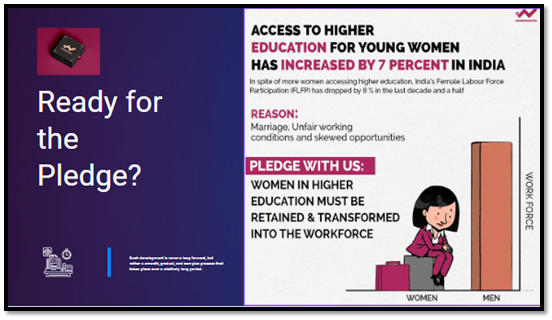
Pledge Now | Reduce Gender Gap | Improve Females workforce participation ratio and Drive Economic Growth
Who should pledge?
Academic institutions (Colleges, schools and training centre, ICT in Vocational and Technical Schools.
To join the campaign, Click Here
Why & What to Pledge with Womennovator?
"We pledge to support efforts to improve female workforce participation ratio and contribute to the economic growth of our country. We recognize that despite millions of females studying, their participation in the workforce remains poor. Therefore, we commit to track the existing percentage of LFPR with Womennovator and identify the factors that hinder their entry into the workforce, and to provide coaching and mentorship to help improve their skills and employability.
We understand that this is not an easy task and will require the collective efforts of all stakeholders. Therefore, we will actively engage with and support Womennovator and it initiative that are working towards improving female workforce participation, and we will use our voice to raise awareness about this issue.
In summary, we pledge to be advocates for female workforce participation and to contribute towards creating a more equitable and inclusive workforce for all."
To understand this initiative more –
The participation of women in the workforce has been on the rise globally in recent years, but there is still a long way to go in terms of achieving gender parity. Women's participation in the labor force has significant economic and social benefits for both individuals and society. In this article, we will explore the current state of female workforce participation, its benefits, and the challenges that women still face in the workplace.
The current state of female workforce participation
According to the International Labour Organization (ILO), the global female labor force participation rate was 47.1% in 2020, compared to 74.7% for men. The gender gap in labor force participation has decreased over the years, but progress has been slow. In some countries, the gap has even widened due to cultural, social, and economic factors.
In developed countries, women's participation in the labor force is relatively high. For instance, the female labor force participation rate in the United States was 57.5% in 2020, while in Sweden, it was 64.6%. In developing countries, however, women's participation in the labor force is lower due to various factors, such as cultural norms, lack of access to education, and discriminatory laws and practices.
Benefits of female workforce participation
The benefits of female workforce participation are numerous and far-reaching. Firstly, it enhances economic growth by increasing the labor force and improving productivity. Women's participation in the labor force increases the overall level of education and skills in society, which in turn boosts innovation and competitiveness. Furthermore, when women have access to decent work, they can contribute to household income and reduce poverty rates.
Secondly, female workforce participation promotes gender equality and empowerment. When women participate in the labor force, they gain financial independence, which improves their decision-making power and autonomy. They also become role models for younger generations, inspiring them to pursue their dreams and break gender stereotypes.
Challenges facing women in the workforce.
Despite the benefits of female workforce participation, women still face various challenges in the workplace. One of the most significant challenges is the gender pay gap, where women are paid less than men for the same work. This gap is prevalent in both developed and developing countries and is attributed to factors such as occupational segregation, discrimination, and bias.
Another challenge is the lack of access to education and training. Women who lack education and training are more likely to be employed in low-paying, low-skilled jobs with limited opportunities for advancement. They may also face discrimination in hiring and promotion, which further limits their career prospects.
Furthermore, women also face barriers in balancing work and family responsibilities, which can result in reduced labor force participation or lower-quality jobs. Gender stereotypes and social norms often lead to the assumption that women should prioritize their family responsibilities over their careers, making it difficult for women to advance in their careers or pursue high-level positions.
To increase the female labour force participation rate (LFPR) in India
Womennovator is a non-governmental organization that aims to increase the conversion rate of women who enter education and then join the workforce, to help increase the female labour force participation rate (LFPR) in India. The organization is inviting colleges to pledge with them to track the conversion rate of women into the workforce after education and provide consistent counselling, which can lead to improvement in the conversion ratio and eventually help improve the economy of the country. Workplace inclusivity is another focus of the organization, where women get recognized, evaluated, and get higher positions. According to statistics, less than 10% of women are part of the formal workforce in India, which has decreased from the early 90s when it was almost 30%. The pandemic has further affected women's participation in the workforce, as they lost their jobs and were several times more likely to lose jobs, without fallback options. The informal economy being almost 90% of the economy has limited the opportunity for formal jobs, leading to a dire situation now. One of the main reasons for the low female LFPR in India is that once families became wealthier, the decision for women to stay back at home became more prominent, and women's economic activity is not seen as important. India's female LFPR rate is consistently falling, and Womennovator is aiming to address this issue by increasing the conversion rate of women who enter education and then join the workforce.
Womennovator is launching a global campaign to tackle the problem of low female labor force participation rates (LFPR), with a focus on colleges tracking and improving the conversion rate of women from education to the workforce. The NGO believes that consistent counselling and focus on workplace inclusivity will lead to an improvement in the conversion ratio, resulting in a direct improvement in the country's GDP and economy. India's female LFPR has consistently fallen over the years and less than 10% of women are part of the formal workforce. The pandemic has hit Indian women harder, leading to more job losses and an inability to re-join the workforce. The decline in women's LFPR is attributed to families becoming wealthier, resulting in women staying at home more often, and an increase in informal jobs. However, raising women's labor force participation can boost a country's GDP and have social benefits, such as a delay in early marriages.
Here are some potential action points for colleges that aim to increase the conversion rate of women who enter education and then join the workforce in India:
Track the conversion rate of women from education to the workforce: Colleges can pledge to track the conversion rate of female graduates into the workforce after completing their education. This will help colleges identify any potential barriers or challenges that may be hindering women's entry into the workforce.
Provide consistent counselling and support: To improve the conversion ratio of women into the workforce, colleges can provide consistent counselling and support to female students. This can include career counselling, mentorship programs, and job placement services to help female students make a smooth transition from education to the workforce.
Encourage workplace inclusivity: Colleges can encourage workplace inclusivity by promoting gender diversity in the workforce and creating a supportive work environment that encourages women to pursue leadership positions. This can be achieved through awareness campaigns, training programs, and networking events.
Develop partnerships with industry leaders: Colleges can develop partnerships with industry leaders to provide students with access to real-world job opportunities and internships. This will help students gain valuable work experience and develop the skills needed to succeed in their chosen careers.
Offer training and skill-building programs: Colleges can offer training and skill-building programs to female students to enhance their employability and help them succeed in their chosen careers. This can include programs focused on developing communication skills, leadership skills, and technical skills relevant to the job market.
Raise awareness about the benefits of women's labour force participation: Colleges can raise awareness about the benefits of women's labour force participation, including the positive impact it can have on the country's GDP and economy, as well as the social benefits such as delaying early marriages and promoting gender equality.
By implementing these action points, colleges can play a crucial role in increasing the conversion rate of women who enter education and then join the workforce in India and help boost the country's economy and social development.
There are several ways to encourage women to increase the conversion rate of women who enter education and then join the workforce, to help increase the female labour force participation rate (LFPR) in India. Here are some possible strategies:
Provide career counselling and guidance: Many women in India lack access to career guidance and information about job opportunities. By providing counselling and guidance to women in colleges and universities, they can be better equipped to make informed decisions about their careers and pursue opportunities that align with their skills and interests.
Create mentorship programs: Mentorship programs can be a powerful way to support women in their careers. Connecting women with successful professionals in their field can help them navigate challenges, gain new skills, and build their networks.
Promote workplace inclusivity: It is important to create a work environment that is inclusive of women, where they feel valued and supported. This includes policies that address issues such as harassment, equal pay, and family-friendly benefits like flexible work arrangements.
Increase access to childcare: Childcare responsibilities often fall disproportionately on women, making it difficult for them to enter or remain in the workforce. By increasing access to affordable, high-quality childcare, women can balance work and family responsibilities more effectively.
Address societal attitudes and biases: Addressing societal attitudes and biases that discriminate against women is essential to increasing their participation in the workforce. This includes challenging stereotypes about gender roles and promoting positive representations of women in the media.
By taking these steps, we can work towards increasing the conversion rate of women who enter education and then join the workforce, which can help to improve the female labour force participation rate (LFPR) in India
Sources:
https://data.worldbank.org/indicator/SL.TLF.CACT.FE.ZS?locations=IN
https://www.weforum.org/agenda/2018/01/the-time-has-come-for-women-to-thrive-heres-how/
https://www.ilo.org/wcmsp5/groups/public/---dgreports/---inst/documents/publication/wcms_250977.pdf
https://docs.iza.org/dp9485.pdf
https://www.ilo.org/wcmsp5/groups/public/---dgreports/---inst/documents/publication/wcms_250977.pdf
https://onlinelibrary.wiley.com/doi/full/10.1111/gwao.12506





